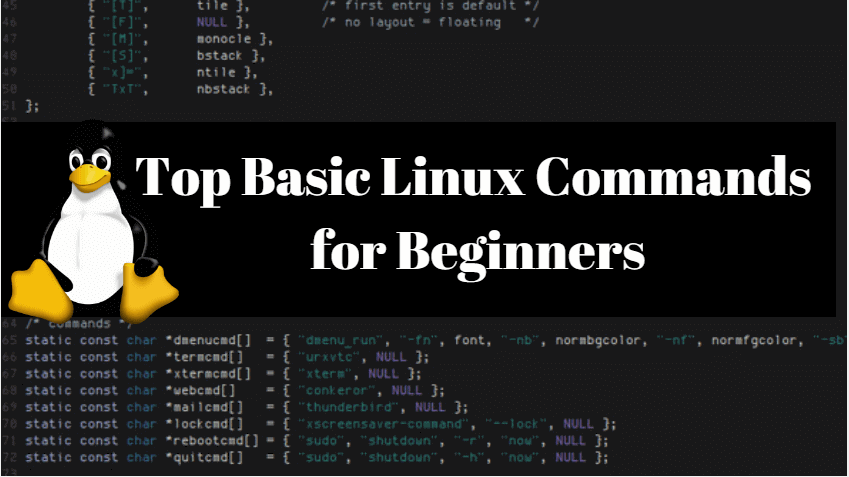Linux is also the operating system’s kernel and a UNIX clone. The Linux operating system is open-source and has been made available by Linus Torvalds free of charge. To download the Linux operating system, go to the official website and download it for free. There are several types of Linux Operating System Linux Mint, Ubuntu, Red Hat Enterprise Linux, Debian, Fedora, and Kali Linux. In most multinational companies, Linux is mostly used in servers. Linux is very safe and fast and it is also free. Does any virus in Linux not work? Linux kernel is also used in smartphones as per the computer’s operating system. Today we will learn about ‘Top Basic Linux Commands for Beginners’.

Follow the Below Article For Basic Linux Commands:
If you do not have knowledge of Linux commands, then do not use some Dangerous Linux commands. In the previous articles, we learned how to install the Linux operating system, let us see which basic Linux commands are used in this Linux operating system. To use Linux command, we have seen what are the ‘Best Linux Terminal Emulators‘. You can use different types of Linux Terminals.
1) ls Command:
By entering Basic Linux commands ‘ls‘, you can see what is in our directory.

2)ls -l Command:
Enter ‘ls -l‘ command to show in the directory files and folders list.

3)ls -a Command:
By entering ‘ls -a‘ you can see hidden files and folders.

4)lsblk Command:
The command ‘lsblk‘ is used to get information about all the block devices in the system. Enter the command lsblk in the terminal and check the information in the list. If you enter ‘-a‘ and ‘-b‘ with the command ‘lsblk‘, the print is displayed in size bytes. Along with the command Lsblk, the ‘-e’, ‘-i’, ‘-d’ will be displayed in the exclude list, include list, and nodeps.

5)uname -a Command:
Enter ‘uname‘ command to see your system information. See all the information in the system by entering the ‘-a‘ followed by ‘uname‘ command.

6)cal Command:
Enter the ‘cal‘ command to see the calendar in Linux Trunk. Also, enter any month of the month and month ahead of cal and year to go directly into the month.

7)date Command:
To see the current date, type ‘date‘.

8)clear Command:
Enter clear to clear the terminal screen.
root@itsmart :-# clear
9)cmp Command:
The command cmp can byte by byte by comparing the file.
root@itsmart :-# cmp file1 file2
10)cp Command:
The cp command is used to copy files and directories.
root@itsmart :-# cp/home/itsmarttricks/file1 /home/itsmart/Personal/
11)df Command:
To check your system’s disk space usage, use ‘df‘ as the following command.
root@itsmart :-# df -h
Also Read – Best Useful Linux DF Command With Examples
12)exit Command:
To exit the terminal, type the ‘exit’ command.
root@itsmart :-# exit
13)who Command:
Type ‘who’ in the terminal to see which user is currently logged into the system.
root@itsmart :-# who
14)w Command:
‘w‘ command is used to display system uptime and to show other user information.
root@itsmart :-# w
15)ssh Command:
‘ssh‘ command allows you to remotely access the system.
root@itsmart :-# ssh itsmart@192.168.77.50
Also Read – Most Useful SSH Command And SCP Command With Examples
16)shutdown Command:
shutdown Command lets you power down your system and also reboot, halt, and power-off.
root@itsmart :-# shutdown --poweroff
17)scp Command:
‘Scp‘ command is used to copy files from your network system safely.
root@itsmart :-# scp~/test.txt root@192.168.77.50:/root/test.txt
18)rmdir Command:
The command rmdir is used to delete empty directories in a system.
root@itsmart :-# rmdir /backup/all
19)rm command:
To delete any files or directories in the system, use the ‘rm‘ command.
root@itsmart :-# rm testfile root@itsmart :-# rm -rf testfile1
Also Read – Best Linux RM Command With Examples
20)ping Command:
The ping command is used to check connectivity in the network or to check the Internet.
root@itsmart :-# ping itsmarttricks.com
21)passwd Command:
The user in your system used the ‘passwd‘ command to create a password. In the previous article, you see ‘How To Reset Forgotten Kali Linux Root Password‘ and ‘Step by Step Change Root Password In Kali Linux 2018.1‘.
root@itsmart :-# passwd itsmart
There are many commands in Linux, we have seen some Linux commands in them. I hope this article will be useful to you. If you like this article, just share it so that it can be used by new Linux learners.
